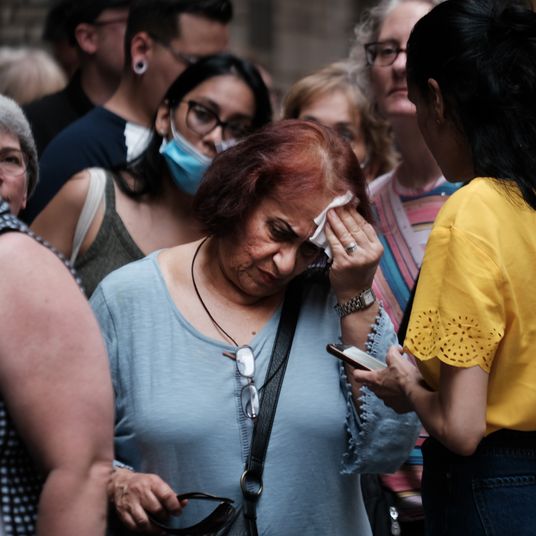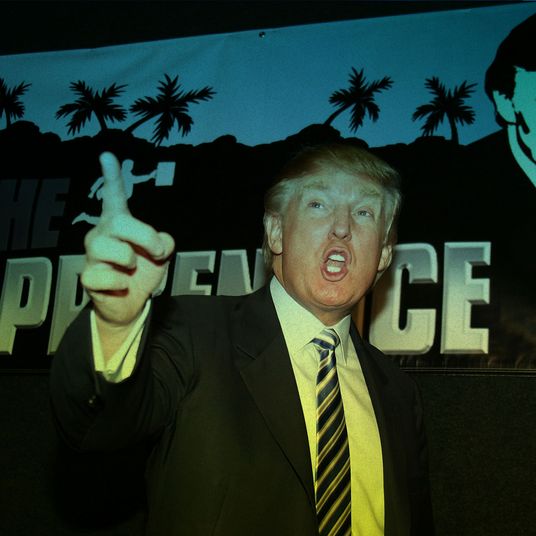
The skies on the East Coast had turned an apocalyptic shade of orange, and everywhere, it seems, people’s minds have turned to smoke. So it felt almost preordained when I recently picked up a copy of John Vaillant’s Fire Weather: A True Story From a Hotter World, which was published on June 6, the same day that Mayor Eric Adams first told New Yorkers to limit outdoor activities. A review of the book in the New York Times called it a “a gripping yarn” and a “painstaking history,” both of which are true. But, as I learned, it also provides a refreshingly clear explanation of this hazy, uncanny moment in the earth’s history. “This is not planet Earth as we found it,” Vaillant writes. “This is a new place — a fire planet we have made, with an atmosphere more conducive to combustion than at any time in the past three million years.”
Vaillant is the type of journalist who picks a single narrative and monomaniacally researches it, plunging himself deeper and deeper into the murky details, and then emerges, many years later, with a small universe cupped in his hands. For his first book, The Golden Spruce, he told the story of a deluded environmentalist who cut down a rare tree that was sacred to the Haida people; the universe around that story was the history of logging, wilderness management, and indigenous sovereignty on Canada’s west coast. His second book, The Tiger, was about the hunt for a man-eating Siberian tiger, but it was also about the cloistered world of Russian forest dwellers, the challenges of conservation, and the mythic place that big cats hold in our imagination. In both books, “man” and “nature” collide, bursting open to reveal the cosmic complexity of each as well as their deep entanglement.
In Fire Weather, Vaillant tells the story of the Fort McMurray wildfire, which took place seven years ago, leaving behind destruction that, as Vaillant describes with eerie specificity, closely resembled the hypocenter of an atomic-bomb blast. As in his previous books, the narrative is by turns heart-racing and horrifying. But the story is not just about what happened to this one city. It is about what Vaillant calls “the new reality of 21st-century fire” — the carbon-fueled feedback loop that is making wildfires bigger, faster, and more unpredictable than ever in recorded history.
We called up Vaillant at his home in Vancouver, to ask him a few (cough, cough) burning questions about smoke, fire, and life on an ever-more flammable planet.
Let’s start with the topic of smoke. Do you have any tips you’ve picked up from the people of Fort McMurray, for whom this type of smoke has become pretty familiar?
Oh, just generally the advice that I’m sure all New Yorkers have heard. You know, stay inside, keep the windows closed, have some kind of air filter going. I think if you are not health-compromised, a few days of bad smoke is not going to have a lasting impact on you. That said, the men and women who were in Fort McMurray during that fire, in part because they were around so many burning houses and burning cars, they inhaled a lot of petrochemistry, and their lives are definitely compromised. All those chemicals get into your bloodstream, into your lungs, even into your nervous system. It’s similar to the kind of mysterious conditions that plagued first responders after 9/11. They’re all resigned to the fact that they will not live as long or as healthily as they would have. It was an anomalous situation. But it was a glimpse of the future too.
You just published an essay calling this state of affairs — the continentwide smoke plumes, the megafires—“the new abnormal.” What’s so apt about that phrase is that it never really gets to where it feels normal, does it? No matter how many times you experience wildfire smoke (or, worse, actual wildfires), it always remains otherworldly and horrible …
I personally refuse to recalibrate to that reality. I will never call it normal.
Something that might be useful to think about here, a kind of analogy, is that there’s a thing called the Cascade Effect. It’s when one system starts to break down, there are all these other consequences that you never think of. So, for example, the permafrost is melting. Well, you’ve got pipelines all through Alaska and northern Canada that are mounted on permafrost. And when the permafrost starts to melt, the pipelines distort and rupture and leak. So now you have this whole other host of problems of oil leaks where you’ve never had them.
Right. It’s like dominoes falling …
Yeah. But they’re falling at weird angles.
Wildfire strikes me as a perfect metaphor for climate change in some ways , because it’s the result of combustion, which is ultimately the source of the problem.It destroys homes on the local level, disrupts whole ecosystems. And yes, the least powerful people will inevitably be the most affected by it. But it also releases all this smoke, which doesn’t care about borders. It invades everything — our homes, even the capillaries in our brains.
Exactly. I’m probably not the first person to say this, but we’re all downwind. We are all connected. It’s not just a California problem; it’s not just a Canada problem. We really are going to go through this impending future together. That’s why I wrote Fire Weather, because I understood that these were stories from the near future, and these people had survived them and learned some really hard lessons that the rest of us haven’t been forced to learn yet.
So, what’s going on in the heads of Canada’s conservatives right now? Is this waking them up?
There’s a desperate bid to maintain the status quo. One thing I learned from hearing about people’s experiences in these fires was how hard they will fight to hold onto the life that they know and love. They will not give up until the fire is literally at their door.
I was going to ask, have you seen any glimmers of hope coming from Fort Mac, in terms of people who have experienced this firsthand having a political awakening?
Nope. Not one.
Fuck.
I really got to know these people. These are people who cried in front of me, who got drunk with me, who told me their deepest secrets. One guy, who got screwed over by the oil company that had employed him for decades, said, “I don’t know who to trust anymore. I don’t know what to trust anymore.” But still, he will not talk about climate change and he will not let go of his loyalty to the petroleum industry. I’m starting to think of it more as a religion.
One of the things that I’ve noticed with these sort of petro-evangelists is that they tend to respond to big wildfires in a very predictable, stereotypical way. Bill McKibben said today that whenever he tweets about wildfires, he’s swarmed with people saying, “It’s always been like this!”
The same thing is happening to me! There are, like, three responses. One of them is, “There’s always been fires!” The other is, “Look at this graph: Much less area is being burned now than historically.” Which actually just … isn’t true. And then the third thing is, “It’s arsonists!”
Forest arsonists?
Yes. The premier of Alberta, Danielle Smith, is saying it’s arsonists who are lighting these fires, and they’re probably liberals trying to sabotage the petroleum industry …
…Which makes it all into a little morality play, in which the bad guy can be caught — if such a bad guy even exists — distracting everyone from the larger systemic issue.
Totally. And, the thing is, there’s always a grain of truth. There have always been wildfires. Some of these fires almost certainly were started by people.
But one of the fascinating things you point out in your book is that this is not just regular old fire. At different temperatures and different humidity levels, fire behaves differently. It becomes something far more dangerous. How so?
I coined a term in Fire Weather, “21st-century fire.” You get these pyrocumulonimbus clouds, which are gigantic stratospheric firestorm weather systems that can reach heights of 45,000 feet and can cover 50,000 square miles of area. And inside them is this roiling storm system producing its own lightning, which can basically perpetuate a large wildfire indefinitely. Those clouds were not unheard of prior to the year 2000, but they were so rare that they really weren’t studied. The only times they would generally occur would be when a volcano erupted.
The first “fire tornado” was identified and named in 2003. That happened outside of Canberra, Australia. The second one occurred in Redding, California, in 2018. I went there for The Guardian. It tore 100-foot, high-tension electricity pylons out of the ground. It tore cars in half. It threw F150s through the air, burned them down to the springs. It destroyed everything on a granular level. It really looked like the aftermath of a nuclear blast. So … that’s new. Fire didn’t used to do that.
So there’s a double entendre hidden in the title of your book. Fire weather is the conditions where wildfires flourish. But also, when fires become big enough, they also create their own weather systems …
Both of those. And then the third meaning is that we are entering a new regime in which fire weather could conceivably become the dominant weather. Fire season in California in the 1950s and ’60s was about four months. Now, it’s perfectly common to have fires year-round.
A theme here, and something that I think is hard for us to understand, but it’s actually simple, is we’re now crossing invisible thresholds. Think about your own body. If you raise the temperature of your body by one degree, you’re really gonna notice it. If you raise it by three degrees, you’re gonna have a full-on fever and you’re gonna probably be in bed. And if you raise it by five degrees, you’ll be dead.
A forest is the same. If you’ve got 90-degree temperatures when it’s supposed to be 65 out, and you’ve got humidity levels that are commensurate with Death Valley (as they were in Fort McMurray on May 3, 2016), fire’s gonna do different stuff. The fire that came out of the forest that day into Fort McMurray was projecting radiant heat of a thousand degrees. It was as hot as Venus.
You also make a distinction in the book between “destructive” wildfires and “transformative” ones. Can you explain what those terms mean?
Your average, run-of-the-mill, 1980s wildfire, it would burn a bunch of trees down, and if there was a town in the way, it might burn through the town. But you wouldn’t have the heat that these modern fires are generating. The first time people really saw that was in 2011, in this little town of Slave Lake, south of Fort McMurray. When that fire came in, it burned incredibly fast and incredibly hot to the point that people’s homes were completely burned. All that remained would be, like, piles of nails. Maybe the sheet-metal husk of a refrigerator or the shell of a car. When people went to look for things like lawn mowers, they couldn’t find them because they had vaporized.
There was a front-page headline in the New York Post yesterday urging American readers to “Blame Canada!” for the smoke that’s blanketing the East Coast. Do you think that’s a fair response?
It’s no more logical than blaming arsonists for the fires in Alberta. It’s just ludicrous, simplistic thinking. I mean, we could blame America …
Yeah. America imports the bulk of its lumber from Canada. And the same goes for the tar sands, right? Something like 40 percent of American oil imports come from Canada. So, in a sense, a good portion of that smoke is America’s pollution. It was just made elsewhere.
Totally. And then there’s all the petcoke. Petcoke is the stuff that’s left over from bitumen processing. It’s sold to India and China to run their power plants. That’s American and Canadian petcoke that’s trashing the skies above Beijing and New Delhi.
The Post also claimed that the fires were the result of “bad forestry” and “green ideology” because the Canadian government hasn’t done enough prescribed burning. When I was in Australia during its Black Summer, I remember hearing precisely those same claims. As you’ve pointed out, this is a ploy to distract from the climate crisis, and pinning the blame on environmentalists is a whole new level of derangement. But is there any truth to the underlying claim — that these megafires in Canada are being caused by too little prescribed burning?
Nobody likes smoke. Ask any New Yorker. Nobody likes it. And people used to think you needed to “preserve” the forest. So we had this development, especially postwar, of all these parachute-trained soldiers who were redeployed as “smoke jumpers” in helicopter crews in the forest. And they were really effective at suppressing wildfires. So we’ve had almost a century of very successful wildfire suppression.
The 10 a.m. policy.
Exactly. “Out by 10.” What it replaced was natural fire burning and also, frankly, indigenous burning, which was the original prescribed burn. So now you have forests after a hundred years of fire suppression, and they’re lighting up. This is also after two centuries of rampant logging that just trashed the woods from coast to coast. So, yeah.
Your book feels distinctly of the moment because it takes place in the Athabasca tar sands, a swath of bitumen-soaked land the size of New York State. One of your sources likens it to Mordor. Miles of bare earth, flames shooting into the sky from “flare stacks.” Just this kind of hellscape. And yet, the region produces billions of dollars each year, a huge chunk of the nation’s GDP. So, in effect, you’re peering right into the burning heart of climate change. Was that your intention when you set out — to write a book about climate change?
Not at all. In fact, I made a vow to myself early on that I wouldn’t use the word climate. I’ve broken that vow, obviously, but I really wanted to stay away from the topic. I mean, what Rebecca Solnit is doing and what Bill McKibben is doing is crucial. And I have the deepest admiration for them. But I didn’t want to write one of those books.
You write that Fort McMurray is also the embodiment of what you call “wildfire economics.” Tell us about what that term means.
Wildfire economics is what occurred to me after learning how a big fire can create its own weather. It generates its own energy by creating pyrocumulonimbus clouds, which creates lightning, which lights more fire around the fire’s periphery, which primes the ground and keeps it all going. What these large corporations are able to do once they get big enough is they can set the terms the same way a large firestorm can. They literally changed the laws. That’s part of why we’re in the situation we’re in right now, because of the power of the petroleum industry to manipulate how our civilization runs.
To me, one of the scariest things about climate change is the way that it has this capacity to keep racing on, even after we have tried to pull in the reins. The clearest illustration of that is how the forests burn and then spew out carbon, which makes the climate warmer, which then makes more fires, and on and on …
Yeah. We’ve already supercharged the system. We’re gonna have to go through all the trouble of coming up with a new energy system, and we will still suffer in terms of respiratory issues and high temperatures and wet-bulb deaths and all the horrors that are lurking out there. That doesn’t mean we can’t still live good lives. I mean, I honestly feel hopeful. It’s just, there’s gonna be a cost too.
So, you’ve spent seven years writing this book, immersing yourself in this science, this history, these people’s lives. How has it changed you personally, seeing the world through the lens of fire?
It’s made me much more critical of capitalism, much more critical of my own unconscious appetites. Petroleum, at this point, feels almost like a death wish. I really want to be on the side of the living. I’m someone who has been an absolute beneficiary of the Petrocene age; oil and gas made my life possible and enabled me to go places and do things that would’ve been very hard to do without them. So I feel grateful for that. But a mature person, an aware person, also has to say, this is ultimately not serving myself, my family, my people, or the future. Clearly what’s needed in the world is a more humble approach to how we make our living on earth. That’s a 21st-century project that Homo sapiens are going to have to reckon with. And it’s going to involve a lot of fire, unfortunately.
Related
- Will New York See Another Smokepocalypse This Summer?
- The Wildfire Haze Is Coming Back to New York
- Photos: Smoke Grinds City to a Halt With Relief in Sight





























